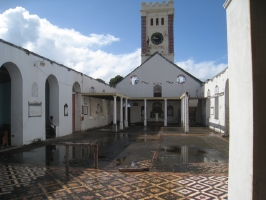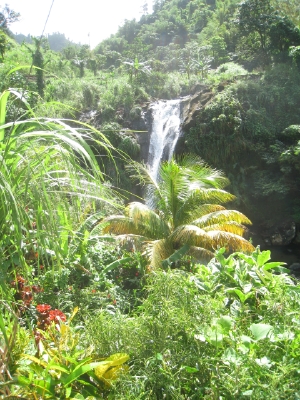
Navigating
this
Cruise Diary:
Diary of a Caribbean Cruise – Part Three
Grenada: the ‘spice island’ and home of my forebears
Sunday, January 23, 2011
My mother was born on the island of Grenada. 11 Her father was a government official; her mother was descended from plantation managers. When my grandfather died – at a fairly young age – my grandmother took her two young daughters to Canada. Slowly their other relatives died off or left the island. Today, there may be distant kin in Trinidad, but none that I know of remain in Grenada.
My sister Janice has an envelope that was addressed to our grandmother in 1915. It is addressed to “Mrs. Donald C. Thompson, Observatory, St. George, Grenada.” Following the English postal system of the day, “Observatory” had to be the name of their house. In 1915 my grandmother would have been expecting my mom, so very likely “Observatory” was the house in which Mom and her older sister, May, were born.
As our cruise ship pulled into the harbour this morning, I hoped that I might be able to locate “Observatory.” What I did manage to do, was, in some senses even better.
Here’s how the day unfolded:
St. George’s Anglican Church
We got off the ship this morning as soon as it docked. Heather and I wanted to attend church, and the service had already begun. Our friends and travel companions, Werner & Mary Schulz, were going to go around the town on foot, and we planned to meet up after church and try to do some further exploring all together.A taxi operator at the pier showed us how to get to the church, and gave us his card in case we might like him to take us touring later on. The card said his name was “Charles – better known as Lollypop.” I liked him instantly, and thought that if we decided to use a taxi, I would certainly want to call him.
He gave us quite a laugh, though. Charles, like many West Indians, uses a singular form where we would use a plural. In directing us to the Anglican church he said, “Along dat road you will get to de step, and de church be right dere.” The “step” turned out to be steps: two steep flights totalling more than twenty stone stairs! This was an enormous chore for Heather, but she was game, and managed them with considerable grace.

Interior of St. George's Church
Hurricane Ivan blew the roof off in 2004
There were cars in the church’s parking lot, so we knew that there were people nearby, but at first we couldn’t find them. Eventually, with the help of a passer-by, we went a short way down the street to what proved to be St. George’s school. A good 75 to 100 people were at worship there. They were engaged in the Exchange of Peace just as we came through the door, and what next happened was, for me, quite overwhelming.
I had phoned St. George’s church office when I was still in Winnipeg, and spoke to the Parish Administrative Assistant, Hermione St. Bernard. All I wanted was service times, but by the end of the conversation Ms. St. Bernard knew about my maternal forebears on the island, and the fact that I am a priest. She therefore made a note of our possible arrival today, and when we came through the door, we were greeted and personally escorted to seats prepared for us at the very front.
When the hubbub of the Peace was done, the Rector, Archdeacon Christian Glasgow, announced who we were, and that I once had family in Grenada. I had forgotten how much respect and prestige is accorded to clergy in the West Indian church. As a priest, I wasn’t just any visitor; I had status. Not only did the Archdeacon ask us to stand, to general applause, he also, in front of everyone, asked me some simple questions about my family quest, which I answered, but added, on impulse, “Everyone here is my family.” I was pleased that this phrase came into my head, because I felt it to be profoundly true in a religious sense, but as soon as I said it, a murmur of approval rippled through the assembly.
I absolutely loved participating in the worship itself. Singing was mighty and plentiful. The liturgy was reverently and carefully done – despite the stacking chairs, lack of kneelers, and other discomforts of an improvised house of worship. Communion was holy and good.
The search for family roots
After church, a woman whose surname was Thompson (my mom’s birth surname) introduced herself, and many others gave suggestions about where my mom’s family had lived. Werner and Mary arrived at the door at that moment, and with their concurrence I called Charles, the taxi driver. He was there in a minute, and before I could speak to him, parishioners had enthusiastically told him to conduct us to “Observatory Road,” where we could look for my mother’s birthplace.We spent the rest of the day being driven about the island by Charles, and it was a wonderful day.
Our first stop, as instructed by the church people, was “Observatory Road.” We drove slowly along it, looking for a 100 year old house that was built, according to one of my cousins, on the foundations of an old fort.
We came to a rather splendid home, that might have qualified, and to my astonishment, Charles drove right into the yard, honked the horn several times, stepped out, and called up to the occupants. “Hello up there!”
A lady came out, and Charles motioned to me: “Go up there, man, and tell her what you are looking for!” The woman motioned me to come up the stairs.
So I went up, and explained about my mother’s birth, about the name “Observatory” and about the supposed foundations. She said, “The house across the road was called “Observatory. Unfortunately it was destroyed by the hurricane. The modern building you see there now is a radio station.”
I looked in the direction she pointed, and there was a cement building standing on the edge of a narrow hilltop. It was easy to imagine that if a fine house were situated there it could be called “Observatory,” because the view was absolutely spectacular. It was equally easy to imagine that the first British or French explorers would have built a fort there, for such a structure would command the sea and the island for miles around.
I was more than satisfied. I believed that I had found the location at least, of my mother’s birthplace. But having introduced herself and her frail and elderly husband, this woman, Yvonne St. John, then went the extra mile: “I will look around in my papers for a photograph of ‘Observatory’ that was taken before the hurricane. Where are you staying, and I will get it to you,” she said. I replied that I was on the cruise ship. “In that case, do you have a business card? I can perhaps email or otherwise send the picture to you, if I am able to find one!”
This was true generosity from a woman whose tranquil Sunday morning had just been interrupted by a honking cabbie and a rather uncomfortable tourist. I thanked her profusely, and, after giving her my card and taking some pictures of “Observatory’s” location, I rejoined the others in the cab.
I had another hoped-for family site to see, and Charles agreeably drove us to the town of Gouyave, where my great grandfather had managed what was then called the “Gouyave Estate.” Grenada produces one third of the world’s nutmeg, plus a number of other spices, and I believe the Gouyave Estate was devoted to such crops. We found an ancient and dilapidated, but still operational, nutmeg processing barn, and nearby the ruins of a “great house” but there was nothing to connect it with any certainty to our family history.
When I visited Grenada in 1972 – I was working in St. Kitts at the time – I went to the home of a great-aunt, Ethel McIntyre. Like my mother’s home, it had a name: “Hillview.” I thought I would recognize “Hillview” on this trip, but I did not see it. That must be for “next time,” I’m afraid.
A memorable tour

Concord Falls, Grenada W.I.
I bought something at the waterfall site, too, mostly because I am a softie and a sucker. There were three or four little shops at the site of the waterfall, and some men called to me, “Why do you spend all your time in that shop and not visit ours as well?” Well, Heather and the Schulzes were enjoying themselves, and I was just standing about idle, so I went to see what these people were talking about. One man showed me his hand-made wares, and complained that not enough people had come up to the falls today from the cruise ship, so how would he feed his children, and look how nice this work is – made from genuine coral!
“It doesn’t look like coral to me, it looks like wood,” said I, but he persisted and insisted, and spoke some more about raising his children. In the end I bought a cross on a string for $10. It’s nicely polished, but I know I was hugely overcharged. I’m not a shopper, and I don’t barter, and I am soft-hearted. Like I say, a sucker.
After spending some time at the waterfall, we were driven across the island through some utterly breathtaking scenery. To our great delight, Charles would stop the car every once in a while, get out, and bring us something to taste. There was a spring, and he filled our waterbottles from it; later there was a tree near the road, and he jumped out, cut off several fruit and brought them to the car. “People are allowed to pluck fruit from trees beside the road even if they don’t own them,” he said, “provided only that they eat the fruit and not try to sell it. Selling such fruit is a criminal offense.” The guava fruit that we had in this fashion was delicious (you can eat every scrap of a guava, by the way: skin, seeds and all). We also had “finger” bananas, and “gourmet” bananas (Charles actually paid for these from a vendor). Then he took us to the Grand Anse beach area, where Heather and Mary put their toes in the water.
Finally, he brought us back to the ship, where I fell asleep exhausted.
An astonishing envelope
Just before we went down to dinner this evening, I found a manila envelope pushed under our stateroom door. It was from Yvonne St.John. She had delivered it to the ship, whose staff then brought it to our room. Inside was a note, and the photographs that she had promised. The photos were taken many years ago; Yvonne herself, somewhat younger, and several others are standing on their own porch, but... framed between the people is a perfect image of “Observatory.” I know that house, as if I had lived in it myself. It is for sure and certain the house in which my mother was born.

Observatory – where Mom was born (photo taken long before Hurricane Ivan destroyed it in 2004) |
Next: Down to the depths, and up to the heavens... (but not on the sea!).
11 “Grenada” is pronounced “Gren-aay-duh” by the inhabitants, not “Gren-ah-dah” like the place in Spain.
Click here to get back to the narrative.
